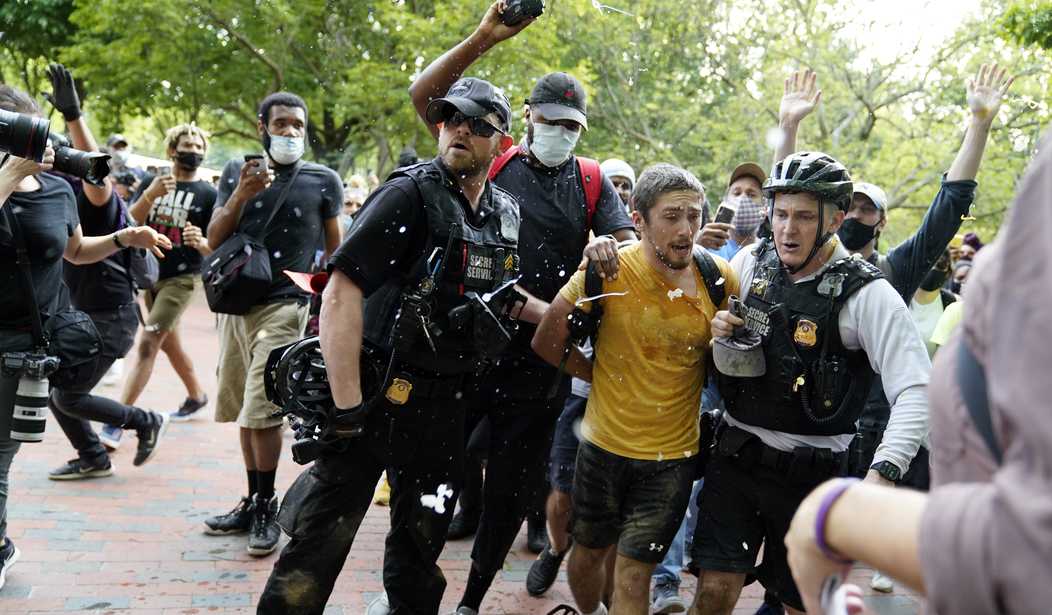The no-longer-hallowed halls of academia?
Conservative columnist and Senior Fellow at The Hoover Institute Victor Davis Hanson not only believes “something went wrong” with America’s universities in the 1960s that has only grown worse in the 21st century; he also blames the mindset of Antifa anarchists and similarly misguided leftists on the “dangerous mess” created by today’s universities.
In an op-ed published on Sunday titled Why Our Universities Have Failed, Hanson begins by asking the following questions.
Where did Antifa youth rioting in the streets receive their intellectual and ethical bearings?
Why are the First and Second Amendments no longer fully operative?
How did the general population become nearly ignorant of their Constitution, history, and the hallmarks of their culture?
Why do employers no longer equate a bachelor’s degree with competency in oral and written communications, basic computation, and reasoning?
How in the 21st century did race and ethnicity come to define who we are rather than become incidental to our individual personas?
“In answering all of these questions,” Hanson wrote, “We always seem to return to higher education — the font of much of our contemporary malaise.” VDH identifies a “perfect storm of events,” many of them, he says, were “reforms with unintended consequences” that have “conspired to end disinterested education as we once knew it.”
The passage of the 26th Amendment in 1971, lowering the voting age to 18—in response to widespread resistance to the draft and the Vietnam War—turned rhetorical campus activism into real progressive block voting.
The campuses were no longer just free-speech zones but woke reservoirs of millions of young voters, a new political and mostly subsidized constituency with clout, to which universities catered.
Globalization enriched the coasts. Seven-billion-person markets were translated into multibillion-dollar endowments of a magnitude never imagined.
The Ivy League, MIT, Caltech, Stanford, the UC system, and dozens of other research universities between Boston and Miami, and San Diego and Seattle, partnered with corporations and solicited foreign government money.
They opened up overseas satellites, welcomed in hundreds of thousands of foreign students, and began adjusting their curricula to reflect transnational issues.
“Floods of cash,” which he lays at the feet of Silicon Valley, Wall Street, Middle East, and Chinese-communist approved conglomerates, among others, created new “centers” and “institutes” on college campuses. “The disconnected result was often bizarre,” he wrote, “students living in upscale campus dorms […] replete with all sorts of influential internships and overseas enrichment—as they cosplayed Marxist activists.
“Massive immigration” has played a large role in the failure of universities, as well, Hanson believes, which, he says, has redefined “diversity” in America, from “the old 88-12 percent white/black American binary,” to “salad-bowl segregation.” As a result, he wrote, class and historical issues “faded in the face of a new dogma of ‘white supremacy.'”
Regardless of their own wealth or absence of past grievance, dozens of ethnic and gender groups now were “victimized” on their claims of a non-white or non-male appearance.
[T]hey demanded reparatory redress in admissions and applications, and institutionalized their lamentations in the hiring of faculty and administrators.
[…]
In the zero-sum game of university curricula, deductive “-studies” courses sprung up to indoctrinate students in “what” to think, rather than inductively how and why. Therapy replaced tragedy in the study of the past and present.
“The wages of debt.”
Hanson believes student debt plays a part in the problem — perceived or otherwise.
In the aftermath of the presidential election, the clarion call on the Left for the federal government to “cancel” student debt has reached a fever pitch, which includes putting pressure on Joe Biden to “forgive” such debt, assuming he becomes president.
Incidentally, “cancel” is a ridiculous misnomer, given that not one dime would be “canceled”; taxpayers would be left holding the bag. Moreover, millions of people who have honored student debt would be screwed in the process, but I digress.
As reported by NBC News earlier this month, student loan debt hit a record $1.6 trillion among 45 million borrowers in February and has only increased during the pandemic. Biden being Biden — or should I say Biden being a Democrat — has pledged to implement a student loan forgiveness plan “immediately,” although he has not committed to widespread student debt cancellation.
Hanson says calls to cancel student loan debt assume three things:
1.Graduates who scrimped and saved either to pay upfront for college or to pay off their debts, are seen as naïve if not delusional. So did paying what they owed prove a chump’s decision?
2. Those who either could never afford college or chose to take their chances in the workplace without a degree, as taxpayers, are now obliged to help pay off what their supposedly better-educated counterparts would or could not?
3. The next cohort of students, hand-in-glove with rapacious colleges, will learn what exactly from debt relief—that they too can borrow without worry on the expectation of yet another eventual amnesty?
Add to that the false notion on the Left that universities are directly responsible for the failure of students who have failed or underachieved, which in turn has led to misplaced anger, and therein lies part of the problem — which is nonsense. College educations neither come with assurances that every graduate will land a high-paying job, nor a money-back guarantee if they don’t. Not to be cruel, but those who work hard, get — and those who don’t, don’t.
VDH addressed the result thusly:
Nothing historically has proven more dangerous to a society than millions of half-educated college students and graduates, indebted, either idle, underemployed, or poorly remunerated, full of pride in their largely suspect majors, and bitter that the supposedly less educated and not as sophisticated cohorts are deservedly making more than they.
[…]
An unemployed sociology graduate, up to his neck in debt, without a good job is a volatile citizen—once he grasps too late in his late 20s that he is no better educated than a plumber or electrician, and far less compensated. Mutatis mutandis, these profiles were the wannabe mid-echelon of the French and Bolshevik Revolutions.
While the country as a whole is pretty evenly split evenly between Red-state conservatives and Blue-state progressives, today’s college campuses are anything but, including — and most critically — left-leaning faculty; educators who Hanson correctly says are “eager to enforce their conformity of thought and ideology on students.”
To borrow a quote from Barrack Obama’s pal and longtime pastor Jeremiah Wright, the chickens of 1960s radicals have come home to roost on college campuses, as former “hippies” and subsequent generations have metastasized within the no-longer hallowed halls of academia.
So here we find ourselves. “What is college for?”, Hanson asks, rhetorically, before answering the question — with questions.
To teach […] and empower skills through a common body of knowledge […]?
To ensure that a student’s future stays inquisitive, enhancing his contribution to his nation?
To inculcate a sense of civics and social morality that emphasizes the values of free speech and expression, individualism, tolerance, public service, and constitutional government?
To seek and reinforce commonalities between citizens of a shared republic?
To the contrary, Hanson wrote, many of our college campuses have become “progressive boot camps.” And the rest is history, as they say — most recently the “history” of 2020.
One wonders how much enjoyment has been derived in 2020 by educators-turned-indoctrinators who have seen the fruits of their labor manifested in the streets of America.
Manifested by anarchists light on education and heavy on indoctrination.














Join the conversation as a VIP Member